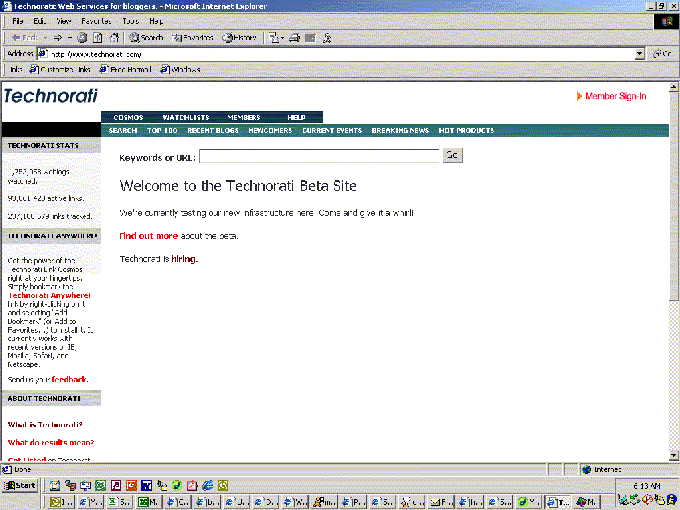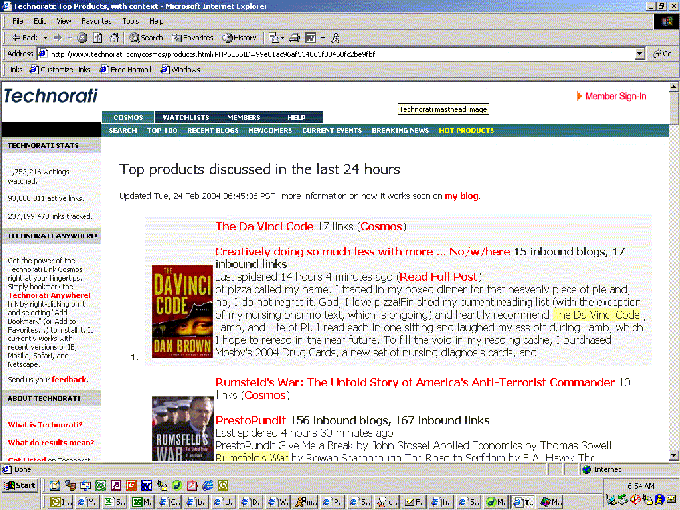From Technorati:
- Technorati is a conversation engine. It tells you what's being said, right now,
about every blog or site that has something to say -- and says it so well that others point
to them. Search for the "cosmos" of any page, and Technorati lists every other page that has
linked to it in the past 24 hours, ranked by freshness or authority. It shows the contextual text
surrounding the inbound link, its age, and other helpful facts. There isn't another search
engine like it.

Technorati has a search box for entering either a key word or a URL. This allows for finding conversations around a topic, a set of key words, or by location. This location could either be a specific blog post, a specific blog, or a site such as the nytimes.com, which will catch all references to all New York Times articles. However, a specific article can also be searched, so that just that conversation can be tracked.

Technorati also has "Breaking News" which they describe as "Breaking News in the blogosphere, new news items reported in the last 12 hours" and "Current Events" which they describe as "Current Events in the blogosphere, based on new blog entries in the last 3 hours." It is unclear from the results of these two sorts how different they are, other than they are different sorts of conversation. However, other than seeing conversations collected over the last 3 or 12 hours, there is no clear indication as to why "breaking" covers that last 12 hours and "current" covers the last 3 hours. Clicking on the highlighted headline at the top of a conversation will connect to the article from traditional journalism sources, and then the highlighted links below connect to blogs that have discussed this article in the last either 3 or 12 hours.
Other links on the site refer to pages that say "coming soon" such as "newcomers" and "recent blogs". Both links are also confusingly named as they appear to describe the same thing, but since nothing is displayed, I cannot tell what the intension is for the definition of these sorts of data.
Other features include creating a watchlist, viewing the top ranked 100 blogs (ranked because they have the most inbound links) and becoming a member, which for bloggers might make some sense because there are some tracking features and api's that can be obtained with membership. The membership feature is difficult to use, the interaction is not flowing or intuitive, and the resulting instructions in email are difficult understand and see what is necessary in order to complete the blog claiming process.

The "hot products" link is described as "Top products discussed in the last 24 hours". This is a really interesting feature because it appears to link together posts talking about books at Amazon with the cover of the book, organized by the most talked about books first. Visually, it is one of the nicest things about the site because the graphical images of the books is engaging and a nice change from all the text on the site.
Strong points
- The fact that blogs and links can be updated so quickly is useful for finding a conversation that has just begun, and a watchlist tracking this would allow a user to step into a conversation quickly;
- Although not relevant to my task, the page for adding a personal blog was an interesting idea, though it was difficult to see how to finish the process based on the email the system sent;
- Being able to look up the latest conversations by both keywork and url, and the flexibility and speed of these search types was very useful;
- Consistently viewing the number of blogs, active links and links tracked is good, as a comparison to the search results as well as overall showing users what the pool of sources is;
- The top products area of the site is visually rich because of the book covers displayed and that differentiates it from the rest of the search or feature sorts which are all text.
Weak points
- Names of various features on the site don't match user's expections of the results they are going to see, or are confusing to the point that the user is unable to tell what the results mean;
- Some links are broken and or in need of updating;
- Search page instructions were lengthy and confusing;
- Sometimes links to a specific blog or blog post, in the context of a conversation displayed, did not route to the blog;
- The website design overall is a little confusing and hard to read due to the fonts and colors.